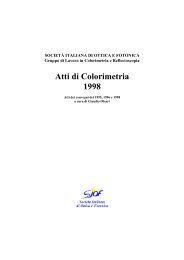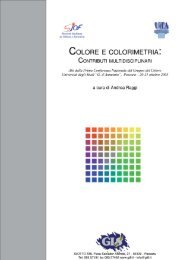Scarica gli atti - Gruppo del Colore
Scarica gli atti - Gruppo del Colore
Scarica gli atti - Gruppo del Colore
Create successful ePaper yourself
Turn your PDF publications into a flip-book with our unique Google optimized e-Paper software.
2. Printer Mo<strong>del</strong><br />
The mo<strong>del</strong> of the printer we refer to is based on the well-known Yule-Nielsen<br />
Spectral Neugebauer equation. According to the YNSN mo<strong>del</strong>, the spectrum of a<br />
N-inks halftone print is the weighted sum of 2 N different colors, called Neugebauer<br />
primaries, given by all the possible overprints of inks. The weight of each<br />
Neugebauer primary is the area it covers in the halftone cell. The YNSN mo<strong>del</strong> for<br />
a 4-ink halftone print is:<br />
R<br />
54<br />
15 1<br />
⎢ n<br />
pr int, = ∑ a p R p,<br />
λ<br />
⎢ p=<br />
0<br />
n<br />
⎡ ⎤<br />
⎥<br />
λ λ = 1..<br />
8<br />
(1)<br />
⎥<br />
⎣ ⎦<br />
where Rprint,λ is the reflectance of the printed color, n is the Yule-Nielsen factor,<br />
Rp,λ is the reflectance of the p-th Neugebauer primary, and ap is the primary area<br />
coverage. The area coverage is the percentage of the halftone cell covered by the<br />
Neugebauer primary.<br />
A mo<strong>del</strong> by Demichel can be used to compute the percentage of the area covered<br />
by each primary. The dot overlap is the product of the relative area covered by<br />
single inks, computed in a stochastic fashion that assumes the ink dots are<br />
randomly arranged. The mo<strong>del</strong> is considered valid for random or rotated halftone<br />
screen [8]; it fails in all cases in which there is a singular screen superposition,<br />
although the color deviation observed is not excessively large [9]. For dot-on-dot<br />
printing a different formulation must be considered [10]. We have used the mo<strong>del</strong><br />
for a random screen, and computed area coverage according to the equations in<br />
Table 1, where c = [ c , m,<br />
y,<br />
k]<br />
represents the concentration of inks for printing a<br />
given color.<br />
We consider each printer an RGB device and mo<strong>del</strong> the driver according to<br />
Equation 2, where the gray component is composed of equal amounts of cyan,<br />
magenta and yellow.<br />
c = c'−U<br />
⋅ k,<br />
m = m'−U<br />
⋅ k,<br />
y = y'−U<br />
⋅ k,<br />
k = min( c',<br />
m',<br />
y'<br />
),<br />
0 ≤ U ≤ 1;<br />
where c' = 1−<br />
r,<br />
m'=<br />
1−<br />
g,<br />
y'=<br />
1−<br />
b .<br />
In our mo<strong>del</strong>, the complex interaction of inks and substrate determining optical and<br />
mechanical dot gains depends upon the wavelength, but also upon the quantity and<br />
number, and types of inks in the halftone. The function used to compute the<br />
effective ink concentration, tuned with only one parameter, is:<br />
(2)





